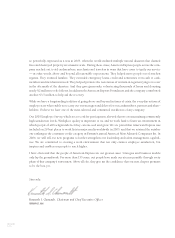American Express 2005 Annual Report Download - page 30
Download and view the complete annual report
Please find page 30 of the 2005 American Express annual report below. You can navigate through the pages in the report by either clicking on the pages listed below, or by using the keyword search tool below to find specific information within the annual report.
Reserve for Membership Rewards costs
Critical Accounting Policies Assumptions/Approach Used Effect if Actual Results Differ
from Assumptions
The Membership Rewards program
is the largest card-based rewards
program in the world, with more
than 1,300 redemption partners
worldwide. The program allows
cardmembers to earn one point for
virtually every dollar charged on
eligible, enrolled American Express
Cards. Many cards offer the ability
to earn double points for certain
types of purchases. Membership
Rewards points are redeemable in a
wide selection of reward categories,
including travel, merchandise and
gift certificates. Points have no
expiration date, and there is no
limit on the number of points one
can earn. A majority of spending by
cardmembers earns points under
this program. Participation,
redemptions and the related
expense under the program have
been increasing. Although the
expense for rewards is recorded as
part of marketing, promotion,
rewards and cardmember services,
the benefits are seen in higher
revenues, lower attrition and faster
speed of payment.
The Company establishes balance
sheet reserves to cover the cost
of future reward redemptions
for points earned to date.
The reserve for Membership
Rewards is estimated using
models that analyze redemption
statistics since the inception of
the program and reflect, to a
lesser extent, management’s
judgment regarding overall
adequacy. The provision for the
cost of Membership Rewards is
based upon points earned that are
expected to be ultimately
redeemed by cardmembers and
the current weighted-average cost
per point of redemption. The
estimated points to be redeemed
by cardmembers are measured
based on many factors including
past redemption behavior of
cardmembers, product type on
which the points are earned,
year of program enrollment, and
spend level. Past behavior is used
to predict when current enrollees
will leave the program and their
ultimate redemption rate on the
points earned to date, but not
yet redeemed. The weighted-
average cost per point is affected
by the mix of rewards redeemed.
The Company continually
evaluates its reserve methodology
for Membership Rewards based
on developments in redemption
patterns, cost per point redeemed
and other factors.
The balance sheet reserve for
unredeemed points is impacted over
time by enrollment levels, amount
of points earned and redeemed,
weighted-average cost per point,
redemption choices made by
cardmembers, reward offerings by
partners and other Membership
Rewards program changes. The
calculation is most sensitive to
changes in the estimated ultimate
redemption rate. This rate is based
on the expectation that a large
majority of all points earned will
eventually be redeemed.
As of December 31, 2005, if the
global ultimate redemption rate
changed by 100 basis points, the
balance sheet reserve would change
by approximately $150 million.
Financial Review
AXP / AR.2005
[28 ]
























